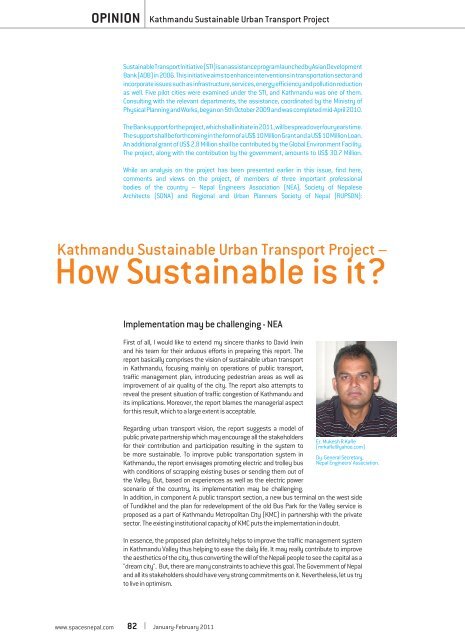1. Jan-Feb 2011
Create successful ePaper yourself
Turn your PDF publications into a flip-book with our unique Google optimized e-Paper software.
OPINION<br />
Kathmandu Sustainable Urban Transport Project<br />
Sustainable Transport Initiative (STI) is an assistance program launched by Asian Development<br />
Bank (ADB) in 2006. This initiative aims to enhance interventions in transportation sector and<br />
incorporate issues such as infrastructure, services, energy efficiency and pollution reduction<br />
as well. Five pilot cities were examined under the STI, and Kathmandu was one of them.<br />
Consulting with the relevant departments, the assistance, coordinated by the Ministry of<br />
Physical Planning and Works, began on 5th October 2009 and was completed mid-April 2010.<br />
The Bank support for the project, which shall initiate in <strong>2011</strong>, will be spread over four years time.<br />
The support shall be forthcoming in the form of a US$ 10 Million Grant and a US$ 10 Million Loan.<br />
An additional grant of US$ 2.8 Million shall be contributed by the Global Environment Facility.<br />
The project, along with the contribution by the government, amounts to US$ 30.7 Million.<br />
While an analysis on the project has been presented earlier in this issue, find here,<br />
comments and views on the project, of members of three important professional<br />
bodies of the country – Nepal Engineers Association (NEA), Society of Nepalese<br />
Architects (SONA) and Regional and Urban Planners Society of Nepal (RUPSON):<br />
Kathmandu Sustainable Urban Transport Project –<br />
How Sustainable is it?<br />
Implementation may be challenging - NEA<br />
First of all, I would like to extend my sincere thanks to David Irwin<br />
and his team for their arduous efforts in preparing this report. The<br />
report basically comprises the vision of sustainable urban transport<br />
in Kathmandu, focusing mainly on operations of public transport,<br />
traffic management plan, introducing pedestrian areas as well as<br />
improvement of air quality of the city. The report also attempts to<br />
reveal the present situation of traffic congestion of Kathmandu and<br />
its implications. Moreover, the report blames the managerial aspect<br />
for this result, which to a large extent is acceptable.<br />
Regarding urban transport vision, the report suggests a model of<br />
public private partnership which may encourage all the stakeholders<br />
for their contribution and participation resulting in the system to<br />
be more sustainable. To improve public transportation system in<br />
Kathmandu, the report envisages promoting electric and trolley bus<br />
with conditions of scrapping existing buses or sending them out of<br />
the Valley. But, based on experiences as well as the electric power<br />
scenario of the country, its implementation may be challenging.<br />
Er. Mukesh R Kafle<br />
(mrkafle@yahoo.com)<br />
Dy. General Secretary,<br />
Nepal Engineers' Association.<br />
In addition, in component A: public transport section, a new bus terminal on the west side<br />
of Tundikhel and the plan for redevelopment of the old Bus Park for the Valley service is<br />
proposed as a part of Kathmandu Metropolitan City (KMC) in partnership with the private<br />
sector. The existing institutional capacity of KMC puts the implementation in doubt.<br />
In essence, the proposed plan definitely helps to improve the traffic management system<br />
in Kathmandu Valley thus helping to ease the daily life. It may really contribute to improve<br />
the aesthetics of the city, thus converting the will of the Nepali people to see the capital as a<br />
"dream city". But, there are many constraints to achieve this goal. The Government of Nepal<br />
and all its stakeholders should have very strong commitments on it. Nevertheless, let us try<br />
to live in optimism.<br />
www.spacesnepal.com 82<br />
<strong>Jan</strong>uary-<strong>Feb</strong>ruary <strong>2011</strong>

















